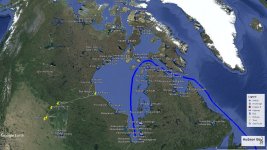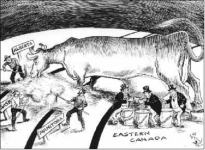I apologize for the quality of the image - I couldn't seem to get the blurriness to disappear.
View attachment 85196
In 1670 a couple of Frenchmen (Radishes and Gooseberries - Radisson and Groseilliers) got fed up paying taxes to the government in Montreal. They approached some French associates in London who convinced some Brits to finance a venture that would allow them to access the interior of North America while bypassing Montreal. They were assisted in their endeavours by Norse folks from the Orkneys and Shetlands that had been sailing those waters since before the Inuit replaced the Cape Dorsets to harvest whale and walrus.
Ruperts Land traded directly with Bristol, bypassing the St Lawrence for 200 years.
In 1870 Montreal bought Ruperts Land from the Hudson Bay Company and started directing trade through the St Lawrence by way of Thunder Bay.
In my opinion....
This facilitated tax collection by Montreal.
It facilitated the National Plan of MacDonald (which also generated the Crows Nest Rate) by which the West would sell grain to eastern merchants instead of furs and the easterners would sell tractors to westerners as well as grain to the world.
The St Lawrence Seaway enhanced and calcified that trade route.
Between the 1880s and 1920s there were some efforts to re-jig the Hudson Bay route but, again in my opinion, there was little political will to support the efforts.
Ruperts Land was acquired as a colony of the Canadas. Shipping out of Churchill, York Factory, Fort Rupert etc would bypass Upper Canada (Toronto, Kingston, Ottawa), Lower Canada (Montreal, Quebec), New Brunswick (The MacKays, Thompsons and Irvines), Prince Edward Island and Nova Scotia as well as BC.
....
Canada as seen from the Prairies in 1915, about the time the Churchill Railway was being promoted.
View attachment 85197
....
Hudson Bay is a Great Lake. A very large version of Lake Superior but with all shores owned by Canada. It is ringed by little villages with anchorages that are connected by air and sea.
Those little villages supply access to the interior of the country and its resources.
The efficient method of connecting them is by water.
Currently the Bay is served from North to South, from Outside to In, by sea from the St Lawrence. It has to wait until the summer for the ships to start arriving.
If the Bay were served from South to North, out of Moosonee and Churchill, the southern communities could be served earlier in the season and for longer.
If Churchill and Moosonee were open then they could start shipping in May-June and ship through November.
This would put the Bay on a similar footing to the Baltic. And the type of shipping already exists to manage that type of support and trade.



